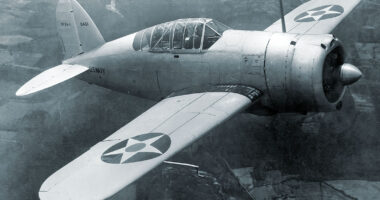On July 13th, 1906, the Wright’s aircraft, the Flyer, flew about a mile and a half at Kitty Hawk, North Carolina. After flying the aircraft, Wilbur Wright said to his brother, Orville, “My boy, what do you think of that?” Orville replied “I do not know what to think of it”. The brothers were on the verge of success in the flying business after years of experimenting with their bicycles, gliders, and kites. Now with the help of their mom and dad, they were ready to go out on their own. Orville was the mechanic and Wilbur was the engineer.
A portion of the proceeds from the sale of this book and the associated merchandise (including the Bearcat replica model R/C plane) will be donated to the West Virginia Public Broadcasting Corporation, “WVUPB”, as part of a fundraiser for the station’s live broadcast of the Airborne & Special Operations Museum “BASE” event.
During the Second World War, the British Royal Air Force faced a shortage of bomber aircraft. A team of Bedfordshire-based engineers named the Bearcat was assembled by the Ministry of Aircraft Production (MAP). The group worked to produce a low-cost, lightweight, and aerodynamic small aircraft, much in the way of the Mosquito, another British aircraft of the day.
All of the common sizes of Grumman’s F8F Bearcat have been made as kits, however the 1/48th scale versions have recently become more difficult to obtain on hobby store shelves. The Hobbycraft kit (HC-1442) is the easiest to find and the most affordable, usually costing slightly over $25. Beginners will like Hobbycraft’s offerings.
The five-piece cockpit should be painted inside green, FS-34151, rather than zinc chromate as recommended on the instructions. Eduard’s prepainted, etched-metal detail set (EDU-48301), which comprises a realistic instrument panel as well as believable pilot’s seat belts, will help the cockpit.
Set the cockpit aside once it’s finished and decide how you’ll arm your Bearcat. Drill the necessary “flashed-over” holes in the bottom wing section—the holes where the high-velocity aircraft rocket (HVAR) and bomb pylons will be attached later. Drill holes for the tank’s centerline attachment point as well. The holes in the upper wing parts must also be drilled out to allow the positioning pins for the 20mm wing cannon blisters. Apply a dab of cement to the pins protruding from the inside of the wing to secure the four little blisters to the outside of the wing. Glue the box-shaped mock-up of the bottom of the engine compartment into the bottom wing center piece before cementing the wing sections together. This section is sculpted to look like the engine compartment’s bottom and serves to obscure the interior of the fuselage. The interior, as well as the wheel wells, should be painted green.
Set aside to dry after gluing the top and bottom wing components together. Fix the finished cockpit to one of the fuselage’s sidewalls. Then, at the back of the cockpit opening, gently glue the turtle deck, which is placed behind the pilot’s armored partition. At this stage, you can also glue the instrument panel in place. All of the inner fuselage elements should be aligned before closing the two sections surrounding them. While the cement sets, you may need to use a couple pieces of tape to hold the fuselage together.
Paint the Pratt & Whitney R-2800-34W Double Wasp engine steel and then dry-brush the cylinders with black, to bring out the details. Next paint the crankcase cover light aircraft gray, FS-16473, and dry brush it with silver to show wear. Set the engine aside to dry.
The wings and horizontal stabilizers, as well as the rudder section that fits into the slot at the top of the vertical stabilizer’s base, should now be glued to the fuselage. The model’s basic structure is now complete. Examine all of the seams, sanding and filling if needed. After that, apply a light coat of light gray primer to any spots that may require attention.
>Most postwar U.S. Navy Bearcats were painted overall glossy dark sea blue, FS-15042. Once you’ve finished painting your model, attach the engine and cowling to the fuselage. Paint the landing gear legs “platinum mist” and the tires flat black. Then glue the completed undercarriage into the wheel wells.
Bearcats were interceptors that could also be utilized for ground assault. Four HVAR and two 500-pound bombs are included in the kit. Push the locating pins on the bottom of the pylons into the holes you bored earlier to secure the weaponry to the underside of the wings.
The Bearcat is armed with four rockets with silver bodies and fins and olive drab warheads, as seen above. I used SuperScale’s decal sheet 48-1082 to recreate a F8F-1B from VF-12A that served aboard the USS Valley Forge in 1948.
The Ursa Major (also known as the Great Bear) is a constellation which lies just north of the celestial equator and is visible during the whole year. It has been associated with great bears for eons of time, and is readily recognizable in the northern hemisphere.. Read more about lenco armored vehicles and let us know what you think.
Related Tags
This article broadly covered the following related topics:
- bearcat car
- bearcat vehicle
- bearcat armored vehicle
- lenco bearcat interior
- lenco bearcat

